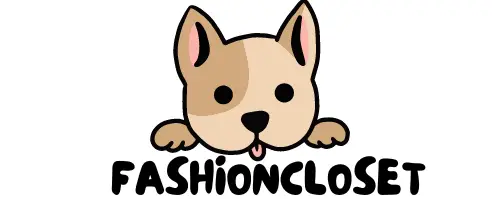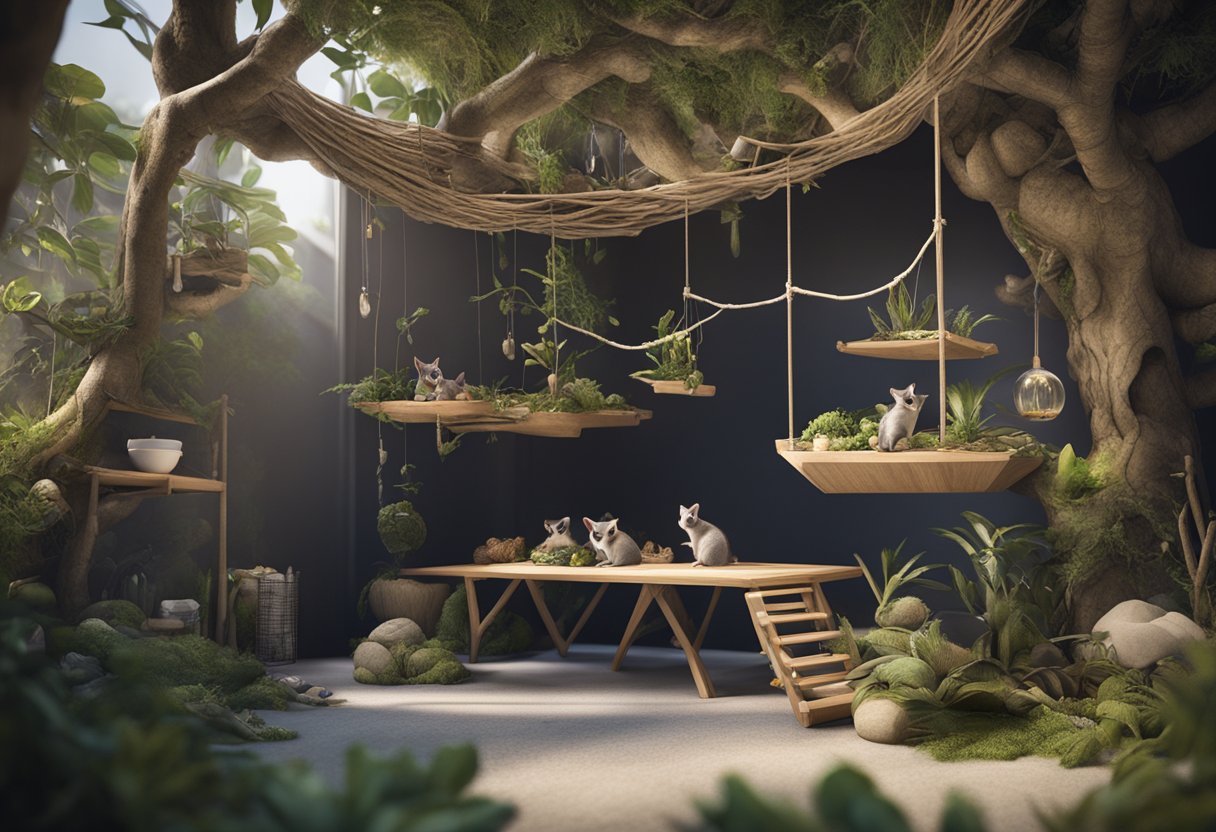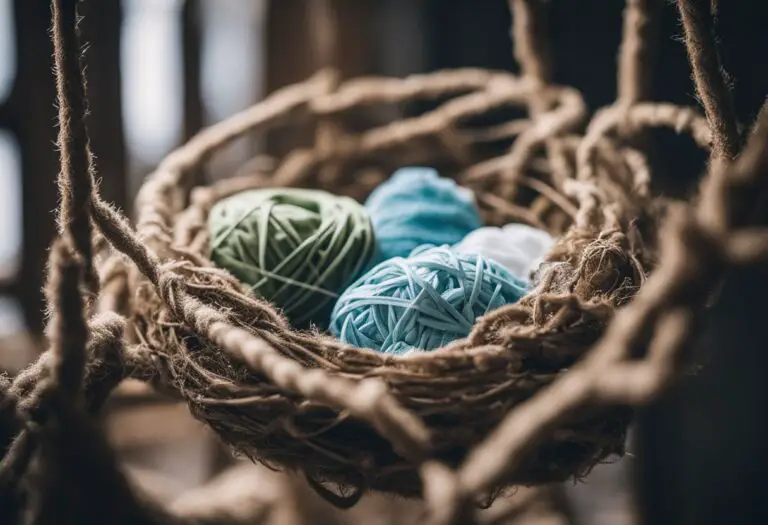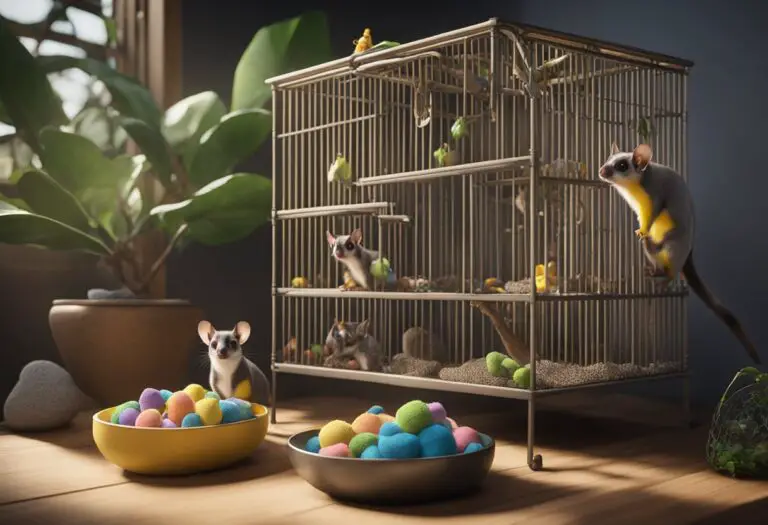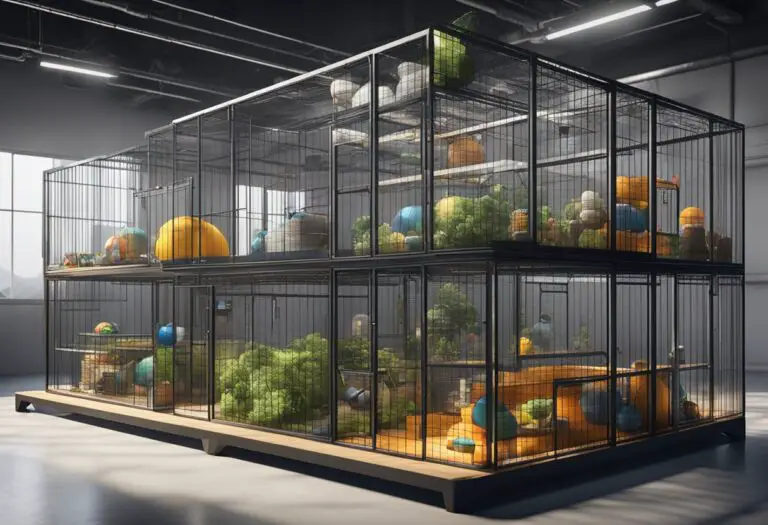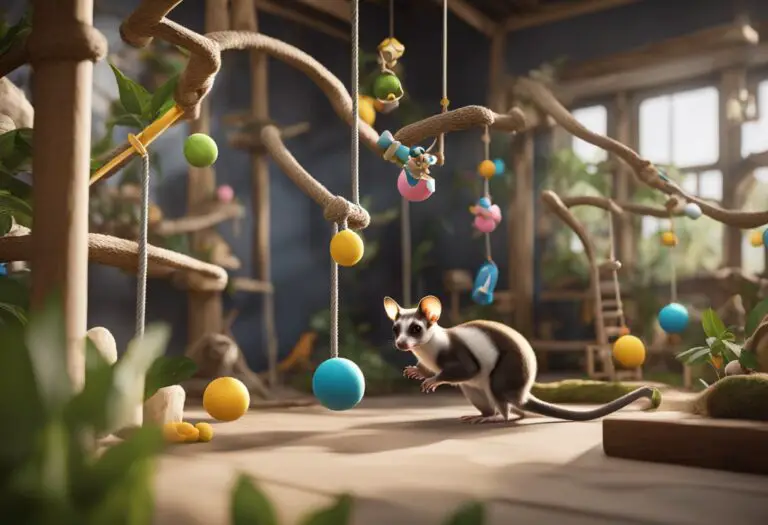Setting Up a Sugar Glider Habitat: A Comprehensive Guide
Providing a comfortable and stimulating home for your sugar glider companions is essential to their overall health and well-being. This comprehensive guide delves into the intricacies of setting up an optimal sugar glider habitat, covering essential aspects such as understanding housing requirements, choosing the right sugar glider enclosure, creating a suitable environment, maintaining the proper temperature and humidity, feeding a balanced sugar glider diet, and introducing engaging sugar glider toys and enrichment. By following the steps outlined in this guide, readers will be able to create a sugar glider habitat that caters to the unique needs of these fascinating creatures, ensuring a comfortable and stimulating home for their furry companions.
Understanding Sugar Glider Housing Requirements
Providing a suitable and spacious habitat is of utmost importance when it comes to caring for sugar gliders. These captivating creatures require an enclosure that not only meets their basic needs but also allows them to thrive and showcase their natural behaviors.
Size and Space Needs
Sugar gliders are agile and active animals, and their sugar glider enclosure should reflect this. The recommended minimum cage size for a pair of sugar gliders is 24 inches wide, 24 inches deep, and 36 inches tall. This ample space allows them to move freely, climb, and explore their surroundings without feeling confined.
It’s important to note that the sugar glider cage requirements may need to be adjusted based on the number of gliders in the habitat. As a general rule, the enclosure should provide at least 2 cubic feet of space per sugar glider to ensure their overall well-being and comfort.
Enclosure Materials and Safety
The sugar glider housing should be constructed using durable and safe materials that can withstand the gliders’ natural behaviors, such as chewing and climbing. Stainless steel or powder-coated metal cages are excellent choices, as they are easy to clean and maintain, and they prevent the gliders from escaping.
In addition to the cage material, the presence of a sugar glider nest box is crucial. These cozy and secure nesting areas provide the gliders with a comfortable retreat, allowing them to feel safe and secure within their habitat.
Choosing the Right Sugar Glider Cage
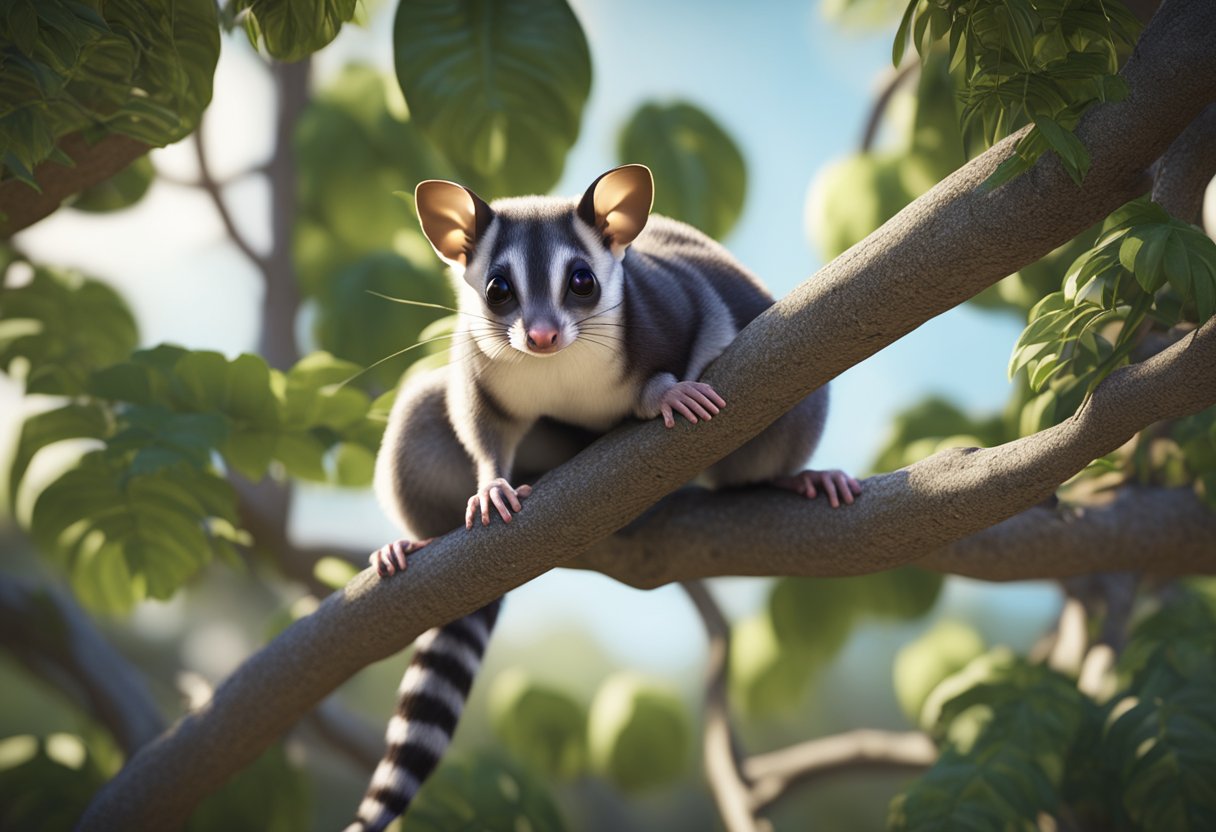
Selecting the appropriate sugar glider enclosure is a crucial step in setting up a comfortable and safe habitat for these captivating creatures. When choosing a sugar glider cage, several key factors must be considered to ensure the well-being and contentment of your sugar gliders.
Firstly, the sugar glider cage requirements dictate that the enclosure should be spacious enough to accommodate the natural behaviors and activity levels of these agile animals. The recommended minimum cage size is 24 inches wide, 24 inches deep, and 36 inches tall, providing ample room for your sugar gliders to move, climb, and explore without feeling confined.
The materials used in the construction of the sugar glider housing are equally important. Stainless steel or powder-coated wire cages are preferred, as they are durable, easy to clean, and resistant to corrosion. Avoid using solid-sided enclosures, as they can limit air circulation and restrict the sugar gliders’ natural climbing and gliding abilities.
In addition to the size and material, the design features of the sugar glider cage play a crucial role in creating an enriching environment. Look for cages with multiple levels, perches, and platforms that encourage natural behaviors such as jumping, climbing, and gliding. Ensure that the cage doors are large enough to allow easy access for cleaning and feeding, and consider incorporating secure locks to prevent unexpected escapes.
By carefully selecting a sugar glider enclosure that meets the specific requirements and accommodates the needs of these unique animals, you can provide a safe, comfortable, and stimulating living space for your sugar glider companions.
Essential Components of a Sugar Glider Habitat
Creating a comfortable and enriching habitat for sugar gliders requires the incorporation of various essential components. These elements not only address the animals’ natural behaviors and needs but also contribute to their overall well-being and contentment.
Nest Boxes and Pouches
Sugar gliders are highly social and instinctively seek cozy, secure spaces for nesting and sleeping. Providing them with strategically placed sugar glider nest boxes and pouches is a crucial aspect of their habitat design. These nesting areas offer the gliders a sense of safety and privacy, allowing them to rest and bond with their colony members.
Branches, Ropes, and Ladders
Sugar gliders are acrobatic and agile creatures, with a natural inclination for climbing and exploring their surroundings. Incorporating a variety of branches, ropes, and ladders within their sugar glider enclosure encourages their natural climbing and gliding behaviors, providing them with ample opportunities for physical and mental stimulation.
Substrates and Litter
The choice of substrates and litter materials in a sugar glider’s sugar glider housing plays a crucial role in maintaining a clean, comfortable, and odor-free environment. Selecting appropriate substrates, such as aspen shavings or paper-based bedding, not only absorbs waste but also allows the gliders to burrow and nest as they would in their natural habitat.
Setting Up a Sugar Glider Habitat
Crafting an optimal sugar glider enclosure and arranging it effectively is crucial for the well-being of these adorable creatures. By meticulously planning the sugar glider housing setup, pet owners can create a visually appealing and functionally efficient habitat that caters to the sugar gliders’ natural behaviors and needs.
Cage Setup and Arrangement
The first step in setting up a sugar glider habitat is to strategically position the cage. Ideally, the sugar glider enclosure should be placed in a quiet, well-ventilated area, away from direct sunlight and drafts. Positioning the cage near a window can provide natural light and stimulation for the sugar gliders, but care should be taken to ensure they are not exposed to excessive sunlight or temperature fluctuations.
Accessory Placement
Once the sugar glider housing is in place, the next step is to thoughtfully arrange the various accessories within the enclosure. Sugar glider nest boxes should be strategically positioned to offer the gliders a cozy and secure retreat, while perches, ropes, and climbing structures should be placed to encourage natural behaviors like leaping, gliding, and exploration. By creating a visually stimulating and functionally efficient habitat, pet owners can ensure their sugar gliders thrive in their new home.
Maintaining Optimal Temperature and Humidity
Ensuring the proper temperature and humidity levels is paramount for the well-being of sugar gliders. Maintaining a comfortable and stable environment is crucial for their health and overall happiness.
Ideal Temperature Range
Sugar gliders thrive in a temperature range of 70-80°F (21-27°C). Exposing them to temperatures outside this ideal range can lead to stress and potential health issues. It is essential to monitor the sugar glider temperature closely and adjust the habitat’s climate control systems accordingly.
Humidity Levels
In addition to temperature, maintaining optimal humidity levels is also crucial for sugar gliders. The ideal humidity range for a sugar glider habitat is between 40-60%. Providing the right level of moisture in the air helps prevent respiratory problems and ensures the overall well-being of these delicate creatures.
By closely monitoring and regulating the sugar glider temperature and humidity, owners can create a comfortable and safe living environment for their furry companions. This attention to environmental factors is a key component in ensuring the long-term health and happiness of sugar gliders.
Providing a Balanced Sugar Glider Diet
Feeding sugar gliders a well-balanced and appropriate diet is essential for their overall health and longevity. These fascinating creatures have specific nutritional requirements that must be met to ensure they thrive in captivity.
Nutritional Requirements
Sugar gliders are omnivores, requiring a diet that includes a variety of nutrients. Their nutritional needs include a balanced intake of proteins, carbohydrates, fats, vitamins, and minerals. Proteins are crucial for muscle development and tissue repair, while carbohydrates provide energy. Fats play a vital role in supporting the sugar gliders’ immune system and regulating body temperature. Vitamins and minerals are essential for maintaining overall health and preventing deficiencies.
Providing a well-rounded sugar glider diet that meets these nutritional requirements is paramount. This may include a combination of high-quality commercial sugar glider food, fresh fruits and vegetables, and protein sources such as cooked eggs or lean meats.
Food and Water Dishes
Choosing the right food and water dishes for your sugar gliders is an important aspect of their care. Opt for shallow, wide-rimmed dishes that are made of chew-proof materials, such as ceramic or stainless steel. This will prevent the sugar gliders from accidentally tipping over the dishes or getting trapped inside.
Ensure that the food and water dishes are placed in areas of the enclosure that are easily accessible to the sugar gliders, allowing them to freely access their meals and stay hydrated throughout the day. Keep the dishes clean and refill them regularly to maintain a fresh and inviting environment for your furry companions.
| Nutrient | Recommended Daily Intake for Sugar Gliders |
|---|---|
| Protein | 15-20% of total caloric intake |
| Carbohydrates | 60-70% of total caloric intake |
| Fats | 10-15% of total caloric intake |
| Vitamins and Minerals | Varied, based on specific nutrient requirements |
Enrichment and Toys for Sugar Gliders
Providing enrichment and appropriate toys is crucial for the mental and physical well-being of sugar gliders. Sugar gliders are highly intelligent and active animals, and they require a stimulating environment to thrive. By introducing a variety of enrichment items and toys, owners can promote natural behaviors and foster their sugar gliders’ overall happiness and well-being.
Promoting Natural Behaviors
Sugar gliders are natural explorers, climbers, and foragers. Incorporating enrichment items that mimic their natural habitats and behaviors can encourage them to engage in these instinctive activities. This includes providing branches, ropes, and ladders for climbing, as well as platforms and ledges for jumping and gliding. Additionally, introducing puzzle feeders or food-based enrichment can stimulate their natural foraging instincts and keep them mentally engaged.
Safe and Appealing Toys
When selecting toys for sugar gliders, it is important to choose items that are safe, durable, and appealing to the animals. Appropriate toys for sugar gliders may include chew toys, soft fabric pouches, and interactive puzzle toys that dispense treats. It is essential to avoid toys with small parts that could be a choking hazard or materials that could be toxic if ingested. Regularly rotating and introducing new toys can keep sugar gliders engaged and prevent boredom.
By providing a variety of enrichment opportunities and carefully selected toys, sugar glider owners can create a stimulating and fulfilling environment for their beloved pets. This not only promotes natural behaviors and mental stimulation but also contributes to the overall health and well-being of the sugar gliders.
Sugar Glider Habitat Maintenance and Cleaning
Maintaining a clean and hygienic sugar glider habitat is essential for the animals’ health and well-being. Regular cleaning and proper maintenance of the sugar glider’s living environment can significantly improve their quality of life and prevent the spread of potential illnesses or odors.
Daily Spot Cleaning
Performing daily spot cleaning is crucial to ensure the sugar glider habitat remains fresh and safe. This involves removing any soiled bedding, wiping down surfaces, and cleaning food and water dishes. By addressing these tasks on a daily basis, you can minimize the buildup of waste and maintain a clean, odor-free living space for your sugar gliders.
Weekly Deep Cleaning
In addition to daily spot cleaning, it is recommended to conduct a more thorough, deep cleaning of the sugar glider habitat on a weekly basis. This includes completely replacing the bedding material, disinfecting all surfaces, and washing any fabric items, such as hammocks or pouches. By following a consistent weekly deep cleaning routine, you can effectively remove any accumulated dirt, debris, and odors, ensuring your sugar gliders thrive in a clean and healthy habitat.
| Cleaning Routine | Frequency | Key Tasks |
|---|---|---|
| Daily Spot Cleaning | Daily |
|
| Weekly Deep Cleaning | Weekly |
|
By following these sugar glider habitat maintenance and cleaning guidelines, you can ensure your sugar gliders live in a clean, safe, and comfortable environment, promoting their overall health and well-being.
Conclusion
In this comprehensive guide, readers have been provided with the essential information and steps needed to set up an optimal habitat for their sugar glider companions. By understanding the sugar glider habitat requirements, choosing the right cage, incorporating essential components, maintaining proper temperature and humidity, providing a balanced sugar glider diet, and introducing enrichment and toys, sugar glider owners can create a safe, comfortable, and stimulating living environment for their beloved pets.
The guidance outlined in this article will enable sugar glider owners to ensure the overall health, happiness, and well-being of their sugar gliders. From establishing the proper sugar glider housing to implementing engaging enrichment activities, every aspect of setting up a sugar glider habitat has been thoroughly covered, empowering readers to provide their sugar gliders with the care and attention they deserve.
By following the steps and recommendations presented in this guide, readers can be confident in their ability to create a thriving and nurturing environment for their sugar glider companions, ensuring their long-term sugar glider care and well-being.
